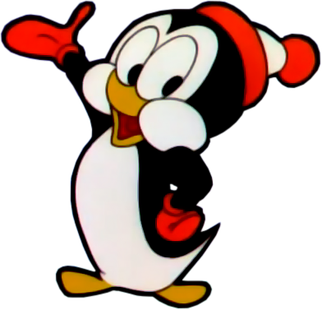Chilly Willy
| Chilly Willy | |
|---|---|
| Woody Woodpecker character | |
 |
|
| First appearance | Chilly Willy (1953) |
| Last appearance | The New Woody Woodpecker Show (1999-2002) |
| Created by | Paul J. Smith (official) Tex Avery (final) |
| Portrayed by |
Sara Berner (1953) Daws Butler (1954-1972) Grace Stafford (1963-1968) "Wee" Bonnie Baker (singing voice in the openings: 1956-1961) |
| Information | |
| Species | Penguin |
Chilly Willy is a funny animal cartoon character, a diminutive anthropomorphic penguin living in Alaska (although, in reality, the species is native only to the Southern Hemisphere). He was created by Paul J. Smith for the Walter Lantz studio in 1953. The character soon became the second most popular Lantz/Universal character, behind Woody Woodpecker.
Chilly Willy was inspired by mystery writer Stuart Palmer, according to Scott MacGillivray's book Castle Films: A Hobbyist's Guide. Palmer used the Lantz studio as a background for his novel Cold Poison, in which the cartoon star was a penguin character, and Lantz adopted the penguin idea for the screen. Chilly's diminutive figure was inspired by an image of Herbert Lee McCormick Jr., a small boy from Fairbanks.
Chilly Willy appeared in 50 theatrical short subjects produced by Lantz from 1953 to 1972, most of which involve his attempts to stay warm, and often meeting opposition from a dog named Smedley (voiced by Daws Butler in his "Huckleberry Hound" voice). Smedley has a large mouth and sharp-pointed teeth (which he shows off when yawning), but is never shown viciously trying to bite Chilly or anyone else with them. There were times, however, when Chilly and Smedley got along, as they did in Vicious Viking and Fractured Friendship. Ironically, Chilly never referred to Smedley by name. Most times that Chilly was in opposition with Smedley, it wound up with the two of them being friends at the end. Chilly was more of a nuisance to Smedley than an enemy, often showing up where Smedley is working, usually for some mean employer. Many times, the notion of a plot was extremely weak, appearing to be a random collection of loosely related gags as opposed to a coherent story.
...
Wikipedia
